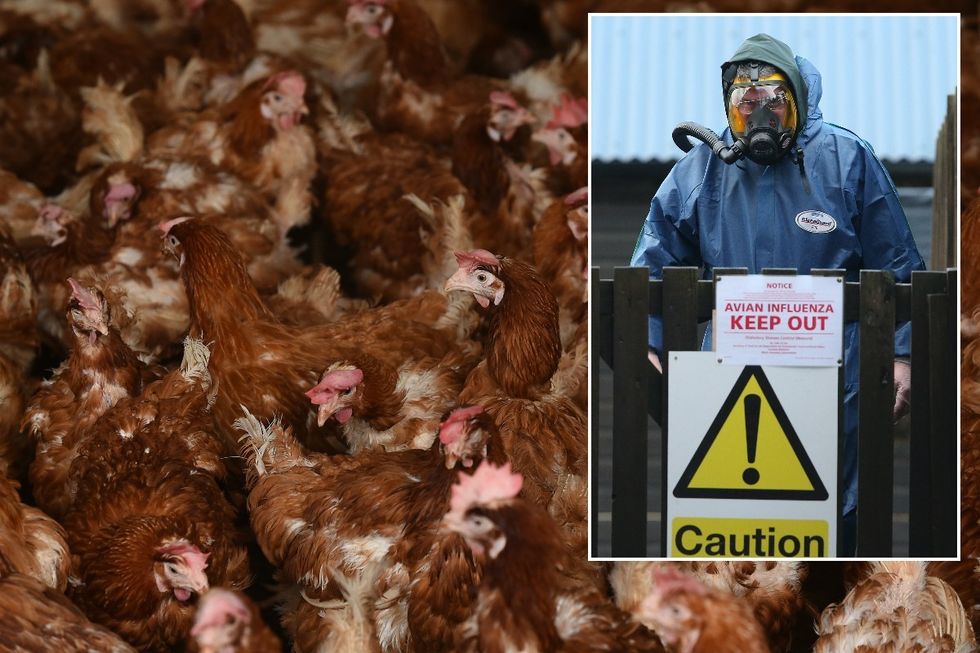A virologist has issued a warning about a new strain of bird flu after an outbreak was detected at an East Yorkshire poultry farm.
Tests carried out at the site near Hornsea revealed the presence of the H5N5 strain of bird flu.
The Department for Environment, Food and Rural Affairs (Defra) announced the finding on Tuesday, marking the second outbreak of bird flu in England this year, following a previous case in February.
Following this discovery, health authorities established a 3 km protection zone and a wider 10 km surveillance zone around the affected site.
Asked by GB News about the specifics of the new outbreak, the UK Health Security Agency (UKHSA) reassured Britons that the risk to the public was “very low”.
Richard Puleston, head of the UKHSA Acute Respiratory Infections Unit, said: “The current risk of bird flu to the UK population remains very low.

Yorkshire poultry farm has started a cull after an outbreak of H5N5 bird flu was detected.
Pennsylvania
“However, the virus can spread to people following close contact with infected birds or mammals and we are closely monitoring people who have been exposed to learn more about these risks.
“Viruses are constantly evolving and we remain vigilant for any signs of evolving risks to the population.
“The UKHSA has preparations in place for the detection of human cases of avian influenza and stands ready to launch an appropriate public health response if this becomes necessary.”
As part of Defra’s containment strategy, all poultry at the East Yorkshire site were humanely culled.
Bird farmers have been urged to remain vigilant and implement measures to protect their flocks, as the virus can be spread through bird droppings, saliva and contaminated food and water.

In 2022, 800 black-headed gulls were found dead at RSPB St Aidan’s, near Leeds and 600 are believed to have died from bird flu near Middlesborough.
Pennsylvania
Professor Paul Digard, chair of virology at the Roslin Institute at the University of Edinburgh, echoed Puleston’s reassuring words to the general public.
The career flu virologist told GB News: “The risk to the general public is very low due to European/UK strains of H5 bird flu in general and for the current H5N5 I am not aware of any no infections recorded in the country. people.
“There is epidemic potential linked to H5 (flu is very variable and the behavior of new strains is sometimes difficult to predict), but the risk linked to the American H5N1 strain of “cattle flu” is much higher, in my opinion. notice.
“This particular strain has not been observed on this side of the Atlantic, however.”
The antiviral specialist who has advised both the NHS and government bodies, said vaccines are available against bird flu and suggested that with “decent biosecurity” the “risk of the virus spreading to people or to other pets” should be reduced.
When asked what was concerning about the H5N5 strain and whether it could have epidemic or pandemic potential, Digard said, “I wouldn’t necessarily pick H5N5 specifically.
“This is ‘just’ the latest iteration of the Clade 2.3.4.4b H5 avian flu, which wreaked havoc on UK poultry and wild birds a few years ago, but which (hopefully) -the) wild birds now have some immunity, which could limit the spread. broadcast of this new version.
“This should reduce the risk to poultry (less virus in the surrounding area) and therefore, with decent biosecurity, should reduce the risk of the virus spreading to humans or other domestic animals.
“The risk is more that it is a new variant, so there is an element of waiting to see how it behaves and for experts (for example in the UK Flu Trailmap consortium) to assess it in the laboratory, just in case he has any unwanted surprises for us.
“The behavior of the US H5 strain (H5N1 B3.13) is more concerning, as it appears to be widespread in birds and dairy cattle and from there it has caused a number of human infections; but fortunately no serious ones.
“The main concern is that this chain of infections in the United States could serve as a gateway for the virus to further change its behavior, become more contagious to people and transmit among them – and this is the potential start of an epidemic, even a pandemic. »
 Previous outbreak of avian flu in 2022 in wild bird populationsPennsylvania
Previous outbreak of avian flu in 2022 in wild bird populationsPennsylvaniaDigard said individuals can help reduce the risk of infection by “avoiding contact with dead birds, especially if they are seen in large numbers” and suggested the public report any sightings of multiple dead birds to Defra .
He also advised keeping pets away from them.
In wild birds, the risk level for avian influenza strain H5 has increased from medium to high.
The Food Standards Agency has confirmed that bird flu poses a minimal risk to food safety, with properly cooked poultry products, including eggs, remaining safe to eat.